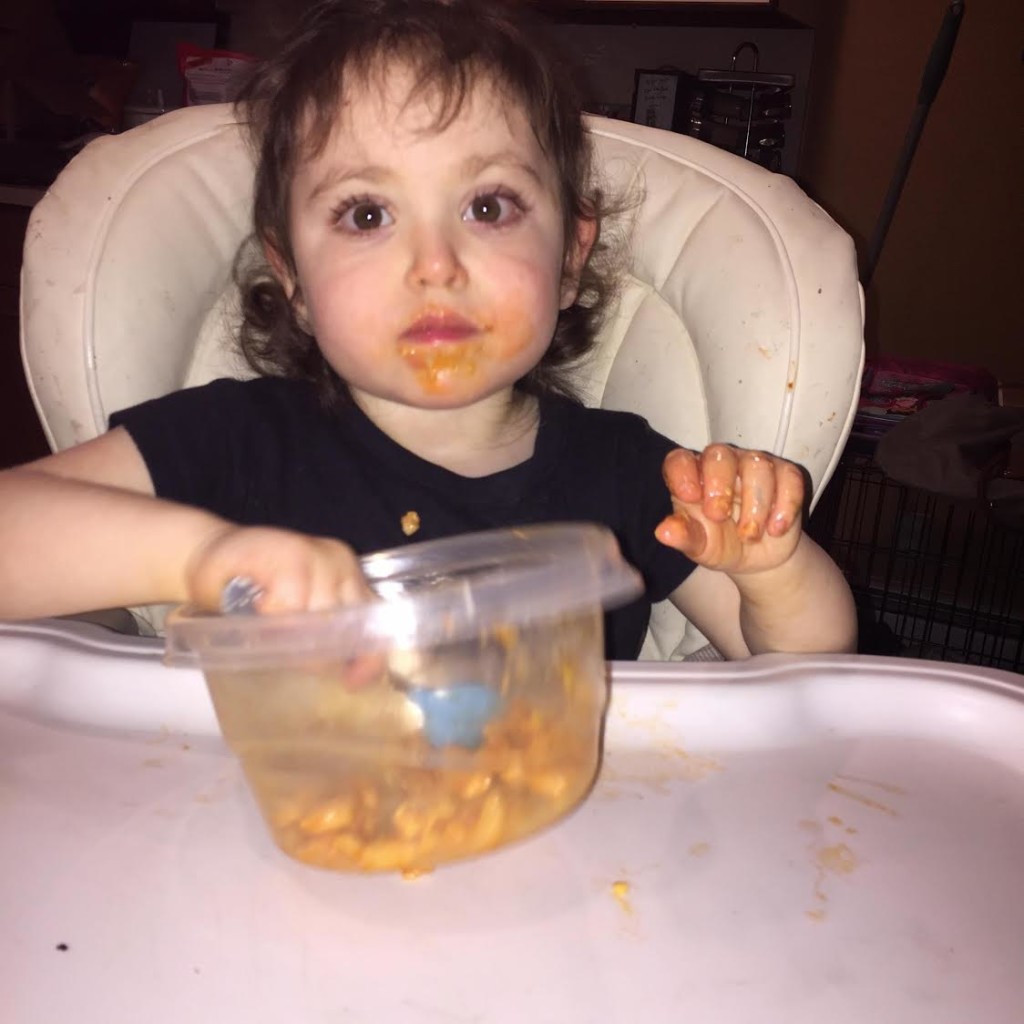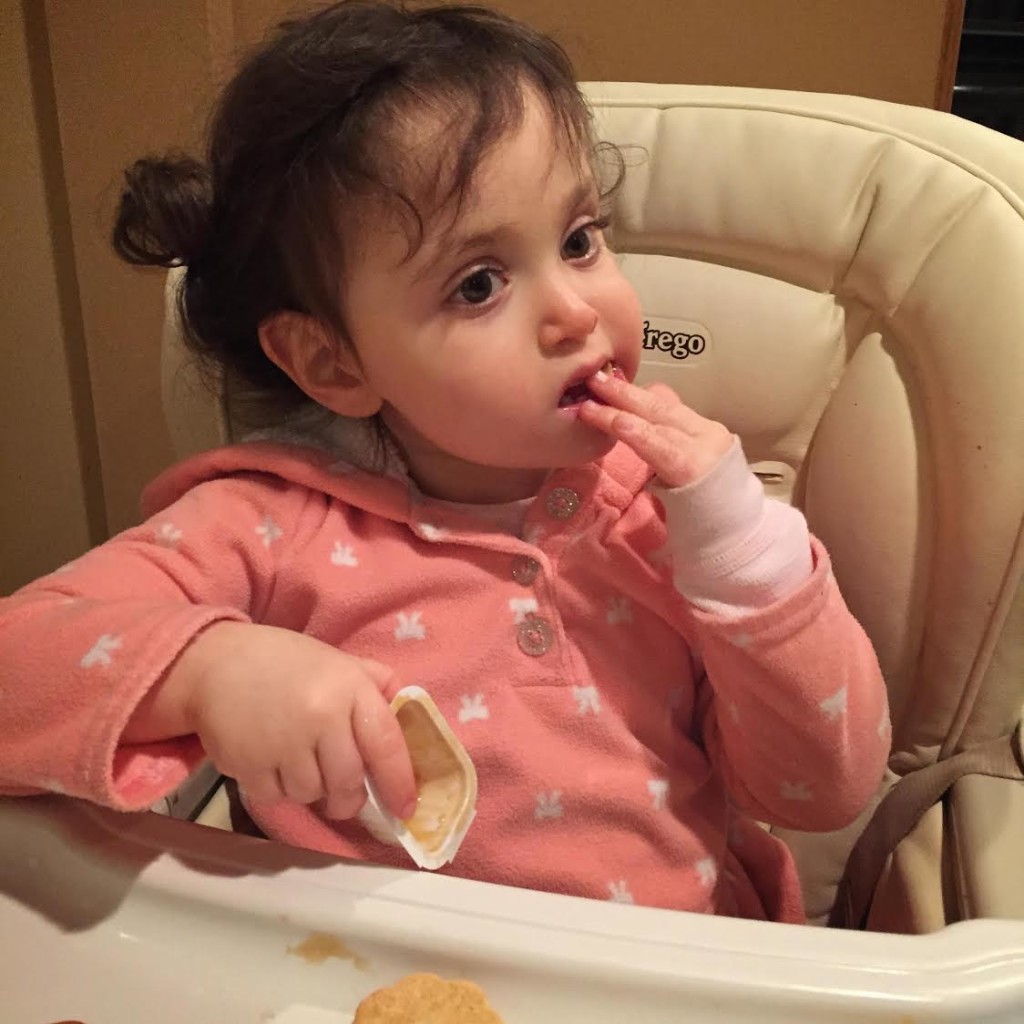A few months ago, we were shopping for leaf blowers at Home Depot and my almost 3-year-old daughter appeared hungry. I reached into my bag and gave her a Trader Joe’s Strawberry crusher. She sat in the shopping cart sucking it down right from the pouch.
While this simple act of feeding my child may seem ordinary to most parents, for those of us whose children suffer from feeding issues, it was huge. To ensure she receives the necessary nutrition needed, my daughter is predominately fed through a tube that is in her stomach–a gastric tube or G-tube.
My daughter Zoey entered this world via emergency c-section. We would later come to learn that she suffered a neonatal stroke. In the NICU she struggled to eat, as do many near-term preemies. She continued to struggle with drinking from a bottle for the first few months of her life. She was labeled “failure to thrive.”
We had a nasal-gastric or NG tube placed when Zoey was 2 months old to supplement her bottle feeds. She hated it. We hated it. At 9 months, we had a G-tube placed, so that she could get enough food directly into her stomach. Later, we would come to find out she had a posterior tongue-tie, which was the actual physical impediment to getting my daughter to eat. We found out her tongue was so immobile it was a miracle she could drink and until her corrective surgery, we stopped trying to get her to eat by mouth (I could go on and on about tongue ties, but that is another post). Once that was fixed, we started the long journey of getting her to eat orally.
Some parents see G-tubes as unavoidable, for others it is a lifesaver, or an opportunity to not stress. I think each parent who has a g-tube fed child has a unique story about their child and how their lives and more importantly, the lives of their children, have changed because of the feeding tube.
While this isn’t an easy way to parent my daughter, I am heartened to share what I have learned about feeding tubes and the people who have them (often referred to as “Tubies,” pronounced like “to-be”):
1. There are several different types of feeding tubes. Some go through the nose and into the stomach, others are directly in the stomach or other parts of the anatomy like the intestines (jejunal feeding tubes). Whatever works for your child is best.
2. Each family has to find their own rhythm for feeding their child and each child has a different tolerance level. Some children are hooked up to pumps for continuous feeds and wear backpacks with the equipment inside. For my daughter, we do three meals of about 4-5 ounces a day via a 60cc syringe hooked up to a plastic extension, which is also called a bolus feed.
3. Most parents whose children have feeding tubes do not know for how long their child will need the tube. We all hope for the day when they are not medically necessary. No, I do not know when that day will come for Zoey, but I hope it will come, some day soon.
4. There is always an underlying medical reason for why a child needs a feeding tube. If I were to stop using a tube to feed my child, she would not suddenly feel hunger and start eating by mouth. Yes, I have tried to give her [insert any food in here]. Because my daughter has behavioral issues with food, there are times coaxing my daughter to eat seems harder than negotiating Mid East Peace! But we are starting to turn a corner on her oral eating.
5. Not all children with feeding tubes will eventually learn to eat by mouth. Fortunately, my daughter can eat orally. If you see me post a picture of her taking bites of McDonald’s, know that she will have that experience followed up with a bolus feed complete with blended kale, broccoli and lots of food most parents would only dream of getting their toddler to eat.
6. Speaking of kale, I should note that I blend real food for my daughter to eat through her feeding tube. It requires one of those (expensive) super blenders like a Vitamix or Blendtec. We are lucky enough to have one and I combine a lot of food into her feeds–taking something from each of the food groups, but going heavy on high calorie items too. I often put her recipes into the myFitnessPal app on my phone, to ensure she is getting enough calories in each 4-5 ounce meal. I also blend separate style meals–breakfast consists of things like waffles and fruit and lunch and dinner are more traditional foods for those meal times like chicken or ground beef, kale, potatoes, broccoli, and some carbs. While it is hard to balance high calorie and nutritional needs, we try our best by using a lot of coconut oil and heavy whipping cream. Blended diets are becoming one of those word-of-mouth/ Internet group sensations that are getting doctors and nutritionists to rethink how tubies are fed. The Internet is amazing.
7. Since my daughter can and is learning to eat by mouth, we call her feeds via g-tube, “Tubie Time.” My daughter is very disconnected from the whole process and watches television (usually the Chica Show) while we have “Tubie Time”. “Tubie Time” is usually announced with a song in our house (sung to the tune of Gummi Bears cartoon from the 1980’s).
8. Vomit. It happens. I’ve gotten very good at guessing when and preparing. I also stopped wearing silk to work and if I do, I get dressed after feeding my daughter in the morning.
9. When feeding in public, I feel akin to breastfeeding mothers: You have a problem with how I am feeding my kid? Too bad, it is how my kid eats. If people have a problem with it, then it is their issue, not mine.
10. The feeding tube does not stop my daughter from doing anything. Her only limitation is swimming in a lake, which her father and I are not fans of anyway. (Her doctor has assured us that lake swimming can easily be mitigated with some plastic wrap around her tummy.)
It’s important to know that feeding tubes offer hope. Sure, it’s an alternative way of eating by mouth, but it is one that gives children–and all people–with no other alternative, a way to thrive.
For more information, please check out these great sites: Tubie Friends, Kids Hope Chest, Real Food Blends.
In addition, The Facebook Feed Tube community and other sites are incredibly supportive and helpful. You can learn more about Feeding Tube Awareness online at: feedingtubeawareness.com and oley.org.
Photo Credit: Laura Klauser













